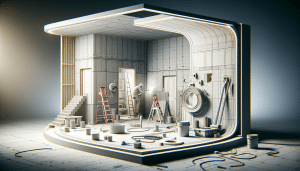Utah Drywall & Repair is your go-to expert for all things drywall. Homeowners often face the challenge of achieving that perfect, smooth finish. This article will guide you step by step on mastering drywall Sanding, ensuring your walls look flawless. From preparation to the final touch, we’ve got you covered.
Contents
Gathering the Necessary Tools
Before diving into the actual sanding process, make sure you have all the necessary tools at your disposal. We’d hate for you to start, only to realize you’re missing something crucial!
First, ensure you have a high-quality drywall sanding block or an electric sander. You’ll also need fine-grit sandpaper, a dust mask, and protective goggles. These tools and safety equipment are non-negotiable if you want to achieve the best results.
Additionally, have a damp cloth and a shop vacuum ready. This will help you manage the dust and keep your work area clean. Trust us; a cleaner workspace leads to a smoother finish!
Understanding Different Types of Sandpaper
It may seem like all sandpaper is created equal, but that’s far from the truth. Choosing the right grit can make or break your project.
For drywall sanding, fine and medium grits are your best friends. Fine-grit sandpaper, usually between 120 and 180 grit, is perfect for achieving a silky smooth finish. Medium grits, ranging from 60 to 100, are more suited for initial sanding.
Always remember, starting with too coarse a grit can create unwanted grooves in your drywall. You want to gently sand away imperfections, not create new ones.
Prepping the Room
Preparation is key to achieving a professional finish. That’s why we emphasize setting up your room properly before starting your sanding project.
Firstly, remove or cover all furniture and surfaces you don’t want to be covered in dust. Use plastic sheeting or drop cloths to protect your valuables.
Next, ensure you have good ventilation. Open windows and doors to allow dust to escape, and consider using fans to improve air circulation. This will help in maintaining a cleaner workspace.
Sanding Techniques
Now that your space is prepped and ready, let’s dive into the actual sanding techniques to use.
Begin by sanding in circular motions. This minimizes visible lines and helps achieve an even finish. Keep your pressure light to avoid gouging the drywall, especially when using an electric sander.
Another important tip is to regularly check your sandpaper. When it becomes clogged, it’s less effective and could even scratch the surface. Replace it as needed to keep your sanding smooth and effective.
Cleaning as You Go
Cleaning as you go might seem tedious, but it’s essential for achieving the perfect finish. Trust us on this one!
Keep a damp cloth handy to wipe down surfaces frequently. This helps to manage dust and allows you to see your progress more clearly.
Additionally, use your shop vacuum to periodically clean up the dust in your work area. The less dust in the air and on the surfaces, the better your final result will be.
Dealing with Corners and Edges
Sanding corners and edges can often be the trickiest part of the process. But don’t worry, we have some tips to make it easier.
For corners, consider using a sanding sponge designed for drywall. These sponges are flexible and can conform to the angles of corners, making it easier to achieve a smooth finish.
When working on edges, maintain a lighter touch to avoid removing too much material. The goal is to blend the edges seamlessly with the rest of the wall.
Final Sanding
Once you’ve tackled the bulk of your project, it’s time for the final sanding. This is where attention to detail is crucial.
Switch to the finest grit sandpaper you have. This allows you to smooth out any remaining imperfections and achieve a polished finish.
Go over the entire surface lightly, paying special attention to high-traffic areas that may need extra smoothing. Don’t rush this step; your patience will pay off with a flawless wall.
Inspecting Your Work
Before you call it a day, it’s essential to inspect your work. This ensures that you’ve achieved the desired level of smoothness.
Use a bright light to highlight any imperfections or scratches that might be less visible in normal lighting. Mark these areas with a pencil so you can easily find and fix them.
Don’t forget to run your hand over the surface. Feeling for inconsistencies can often identify issues that aren’t immediately visible to the eye.
Dealing with Dust
Drywall sanding inevitably creates dust, but dealing with it properly can make all the difference.
Start by using your shop vacuum to clean up as much dust as possible. Focus on both the drywall and the surrounding area.
Follow up with a damp cloth to remove any residual dust from the walls and other surfaces. This ensures a cleaner, smoother application when you’re ready for priming and Painting.
Final Tips for a Perfect Finish
We want to leave you with some additional tips to ensure your drywall sanding project is a success.
- Take Breaks: Sanding can be physically demanding. Taking regular breaks helps you maintain focus and avoid mistakes.
- Stay Safe: Always wear a dust mask and protective goggles to protect yourself from fine particles that can be harmful.
- Stay Organized: Keeping your tools and materials organized will save you time and effort in the long run.
- Practice Patience: Rushing through the sanding process can lead to a poor finish. Take your time for the best results.
- Ask for Help: Don’t hesitate to contact professionals if you encounter issues or need expert advice.
Mastering drywall sanding requires the right tools, techniques, and a bit of patience. However, with this step-by-step guide, you’ll achieve the perfect smooth finish that you desire. Should you need expert help, contact Utah Drywall & Repair by phone # 801-406-6350 or Request a Free Quote.




